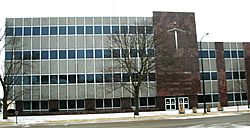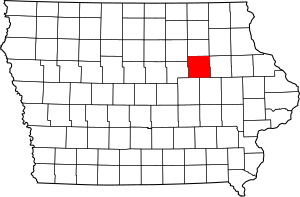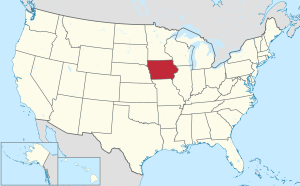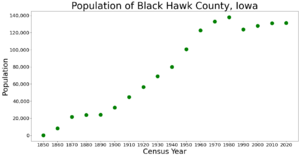Black Hawk County, Iowa facts for kids
Quick facts for kids
Black Hawk County
|
||
|---|---|---|

Black Hawk County Courthouse in Waterloo
|
||
|
||

Location within the U.S. state of Iowa
|
||
 Iowa's location within the U.S. |
||
| Country | ||
| State | ||
| Founded | 1843 | |
| Named for | Black Hawk | |
| Seat | Waterloo | |
| Largest city | Waterloo | |
| Area | ||
| • Total | 573 sq mi (1,480 km2) | |
| • Land | 566 sq mi (1,470 km2) | |
| • Water | 6.9 sq mi (18 km2) 1.2% | |
| Population
(2020)
|
||
| • Total | 131,144 | |
| • Density | 228.87/sq mi (88.37/km2) | |
| Time zone | UTC−6 (Central) | |
| • Summer (DST) | UTC−5 (CDT) | |
| Congressional district | 2nd | |
Black Hawk County is a special area, like a big neighborhood, located in the northeastern part of Iowa, a state in the USA. In 2020, about 131,144 people lived here, making it the fifth most populated county in Iowa. The main city, or 'county seat,' where the government offices are, is Waterloo. Black Hawk County is also part of a larger area called the Waterloo – Cedar Falls metropolitan area, which includes Waterloo and Cedar Falls.
Contents
A Look Back: History of Black Hawk County
Black Hawk County was officially created a long time ago, on February 17, 1853. It was made from parts of another area called Buchanan County. The county got its name from a very important person: Black Hawk. He was a brave leader of the Sauk Native American tribe. The county was named after him because of his role in the 1832 Black Hawk War.
Where is Black Hawk County? (Geography)
Black Hawk County covers about 573 square miles. Most of this area, around 566 square miles, is land. The rest, about 6.9 square miles, is water.
The Cedar River flows through the county. It roughly divides the area into two halves, from the northwest to the southeast. The land here is mostly flat. This is because much of it is on the river's flood plain, which means it's low-lying land near the river.
Main Roads and Highways
Many important roads help people travel through Black Hawk County. These include:
 Interstate 380
Interstate 380 U.S. Highway 20
U.S. Highway 20 U.S. Highway 63
U.S. Highway 63 U.S. Highway 218
U.S. Highway 218 Iowa Highway 21
Iowa Highway 21 Iowa Highway 27
Iowa Highway 27 Iowa Highway 57
Iowa Highway 57 Iowa Highway 58
Iowa Highway 58 Iowa Highway 175
Iowa Highway 175 Iowa Highway 281
Iowa Highway 281
Public Transportation
- Metropolitan Transit Authority of Black Hawk County: This group helps people get around the county using buses.
- List of intercity bus stops in Iowa: You can find places here where buses stop to pick up and drop off people traveling between cities.
Neighboring Counties
Black Hawk County shares its borders with several other counties. These are:
- Bremer County (to the north)
- Buchanan County (to the east)
- Benton County (to the southeast)
- Tama County (to the southwest)
- Grundy County (to the west)
- Butler County (to the northwest)
- Fayette County (to the northeast)
Who Lives Here? (Demographics)
The number of people living in Black Hawk County has changed a lot over the years. Here's how the population has grown:
| Historical population | |||
|---|---|---|---|
| Census | Pop. | %± | |
| 1850 | 135 | — | |
| 1860 | 8,244 | 6,006.7% | |
| 1870 | 21,706 | 163.3% | |
| 1880 | 23,913 | 10.2% | |
| 1890 | 24,219 | 1.3% | |
| 1900 | 32,399 | 33.8% | |
| 1910 | 44,865 | 38.5% | |
| 1920 | 56,570 | 26.1% | |
| 1930 | 69,146 | 22.2% | |
| 1940 | 79,946 | 15.6% | |
| 1950 | 100,448 | 25.6% | |
| 1960 | 122,482 | 21.9% | |
| 1970 | 132,916 | 8.5% | |
| 1980 | 137,961 | 3.8% | |
| 1990 | 123,798 | −10.3% | |
| 2000 | 128,012 | 3.4% | |
| 2010 | 131,090 | 2.4% | |
| 2020 | 131,144 | 0.0% | |
| 2023 (est.) | 130,471 | −0.5% | |
| U.S. Decennial Census 1790-1960 1900-1990 1990-2000 2010-2019 |
|||
What the 2020 Census Shows
In 2020, the census counted 131,144 people living in Black Hawk County. This means there were about 230 people for every square mile. Most people (94.55%) said they belonged to one race. About 73.49% were White, and 10.43% were Black. About 4.92% were Hispanic, and 2.61% were Asian. A smaller number were Native American (0.32%) or Native Hawaiian/Pacific Islander (0.65%). About 7.57% were from other races or more than one race. There were 58,559 homes, and 54,223 of them were lived in.
Cities and Towns in Black Hawk County
Black Hawk County has many different communities, from bigger cities to smaller towns.
Cities
- Cedar Falls
- Dunkerton
- Elk Run Heights
- Evansdale
- Gilbertville
- Hudson
- Janesville
- Jesup
- La Porte City
- Raymond
- Waterloo
Special Designated Area
- Washburn: This is a special area that is counted like a town by the census, even if it's not officially a city.
Other Small Communities
These are smaller places that are not officially cities or towns:
- Blessing
- Dewar
- Eagle Center
- Finchford
- Glasgow
- Voorhies
Townships
Black Hawk County is also divided into seventeen smaller areas called townships. These help organize the county:
- Barclay
- Bennington
- Big Creek
- Black Hawk
- Cedar
- Cedar Falls
- Eagle
- East Waterloo
- Fox
- Lester
- Lincoln
- Mount Vernon
- Orange
- Poyner
- Spring Creek
- Union
- Washington
How Communities Rank by Population
Here's a list of the cities and towns in Black Hawk County, ranked by how many people lived there in 2020:
† county seat
| Rank | City/Town/etc. | Type of Community | Population (2020 Census) |
|---|---|---|---|
| 1 | † Waterloo | City | 67,314 |
| 2 | Cedar Falls | City | 40,713 |
| 3 | Evansdale | City | 4,561 |
| 4 | Hudson | City | 2,546 |
| 5 | Jesup (mostly in Buchanan County) | City | 193 (2508 total) |
| 6 | La Porte City | City | 2,284 |
| 7 | Elk Run Heights | City | 1,069 |
| 8 | Janesville (mostly in Bremer County) | City | 115 (1034 total) |
| 9 | Washburn | CDP | 870 |
| 10 | Dunkerton | City | 842 |
| 11 | Gilbertville | City | 794 |
| 12 | Raymond | City | 759 |
See also
 In Spanish: Condado de Black Hawk para niños
In Spanish: Condado de Black Hawk para niños




